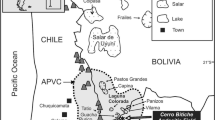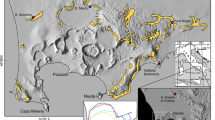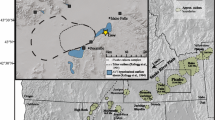Abstract
Triggering mechanisms of large silicic eruptions remain a critical unsolved problem. We address this question for the ~2.08-Ma caldera-forming eruption of Cerro Galán volcano, Argentina, which produced distinct pumice populations of two colors: grey (5%) and white (95%) that we believe may hold clues to the onset of eruptive activity. We demonstrate that the color variations correspond to both textural and compositional variations between the clast types. Both pumice types have bulk compositions of high-K, high-silica dacite to low-silica rhyolite, but there are sufficient compositional differences (e.g., ~150 ppm lower Ba at equivalent SiO2 content and 0.03 wt.% higher TiO2 in white pumice than grey) to suggest that the two pumice populations are not related by simple fractionation. Trace element concentrations in crystals mimic bulk variations between clast types, with grey pumice containing elevated Ba, Cu, Pb, and Zn concentrations in both bulk samples (average Cu, Pb, and Zn concentrations are 27, 35, and 82 in grey pumice vs. 11, 19, and 60 in white pumice) and biotite phenocrysts and white pumice showing elevated Li concentrations in biotite and plagioclase phenocrysts. White and grey clasts are also texturally distinct: White pumice clasts contain abundant phenocrysts (44–57%), lack microlites, and have highly evolved groundmass glass compositions (76.4–79.6 wt.% SiO2), whereas grey pumice clasts contain a lower percentage of phenocrysts/microphenocrysts (35–49%), have abundant microlites, and have less evolved groundmass glass compositions (69.4–73.8 wt.% SiO2). There is also evidence for crystal transfer between magma producing white and grey pumice. Thin highly evolved melt rims surround some fragmental crystals in grey pumice clasts and appear to have come from magma that produced white pumice. Furthermore, based on crystal compositions, white bands within banded pumice contain crystals originating in grey magma. Finally, only grey pumice clasts form breadcrusted surface textures. We interpret these compositional and textural variations to indicate distinct magma batches, where grey pumice originated from an originally deeper, more volatile-rich dacite recharge magma that ascended through and mingled with the volumetrically dominant, more highly crystalline chamber that produced white pumice. Shortly before eruption, the grey pumice magma stalled within shallow fractures, forming a vanguard magma phase whose ascent may have provided a trigger for eruption of the highly crystalline rhyodacite magma. We suggest that in the case of the Cerro Galán eruption, grey pumice provides evidence not only for cryptic silicic recharge in a large caldera system but also a probable trigger for the eruption.
















Similar content being viewed by others
References
Anders E, Ebihara M (1982) Solar-system abundances of the elements. Geochim Cosmochim Acta 46:2363–2380. doi:10.1016/0016-7037(82)90208-3
Andersen DJ, Lindsley DH (1988) Internally consistent solution models for Fe–Mg–Mn-Ti oxides: Fe–Ti oxides. Am Mineral 73:714–726
Bachmann O, Dungan MA, Lipman P (2002) The Fish Canyon magma body, San Juan Volcanic Field, Colorado: rejuvenation and eruption of an upper-crustal batholith. J Petrol 43:1469–1503
Bacon CR, Druitt TH (1988) Compositional evolution of the zoned calcalkaline magma chamber of Mount Mazama, Crater Lake, Oregon. Contrib Mineral Petrol 98:224–256
Bacon CR, Hirschmann MM (1988) Mg/Mn partitioning as a test for equilibrium between coexisting Fe–Ti oxides. Am Mineral 73:57–61
Bacon CR, Metz J (1984) Magmatic inclusions in rhyolites, contaminated basalts, and compositional zonation beneath the Cosa volcanic field, California. Contrib Mineral Petrol 85:346–365
Behrens H, Tamic N, Holtz F (2004) Determination of the molar absorption coefficient for the infrared absorption band of CO2 in rhyolitic glasses. Am Mineral 89:301–306
Berlo K, Blundy J, Turner S, Black S, Cashman KV, Hawkesworth C (2004) Chemical tracers of conduit processes preceding the 1980 eruption of Mount St. Helens. IAVCEI, Pucon
Berlo K, Turner S, Blundy J, Black S, Hawkesworth C (2006) Tracing pre-eruptive magma degassing using (210Pb/226Ra) disequilibria in the volcanic deposits of the 1980-1986 eruption of Mount St. Helens. Earth Planet Sci Lett 249:337–349
Best MG, Christiansen EH (1997) Origin of broken phenocrysts in ash-flow tuffs. Geol Soc Am Bull 109:63–73
Bindeman IN (2005) Fragmentation phenomena in populations of magmatic crystals. Am Mineral 90:1801–1815
Blundy J, Cashman K (2008) Petrologic reconstruction of magmatic system variables and processes. Reviews in Mineralogy and Geochemistry 69:179–239. doi:10.2138/rmg.2008.69.6
Blundy JD, Cashman KV (2001) Magma ascent and crystallisation at Mount St. Helens, 1980–1986. Contrib Mineral Petrol 140:631–650
Blundy J, Cashman KV, Berlo K (2008) Evolving magma storage conditions beneath Mount St. Helens inferred from chemical variations in melt inclusions from the 1980–1986 and current (2004–2006) eruptions. In: Sherrod DR, Scott WE, Stauffer PH (eds) A volcano rekindled: the renewed eruption of Mount St. Helen, 2004–2006. US Geological Survey Professional Paper 1750. US Geological Survey, Reston, pp 755–790
Blundy J, Cashman KV, Rust A, Witham F (2010) A case for CO2-rich arc magma. Earth Planet Sci Lett 290:289–301. doi:10.1016/j.epsl.2009.12.013
Boyce JW, Hervig RL (2008) Magmatic degassing histories from apatite volatile stratigraphy. Geology 36:63–66
Cas RAF, Wright HMN, Lesti C, Porreca M, Folkes C, Giordano G,Viramonte J (2011) The flow dynamics of an extremely large volume pyroclastic flow, the 2.08 Ma Cerro Galán Ignimbrite, NW Argentina, and comparison with other flow types. In: Cas RAF, Cashman K (eds) The Cerro Galán ignimbrite and Caldera: characteristics and origins of a very large volume ignimbrite and its magma system. Bull Volcanol (in press)
Cioni R, Civetta L, Marianelli P, Metrich N, Santacroce R, Sbrana A (1995) Compositional layering and syn-eruptive mixing of a periodically refilled shallow magma chamber: the AD 79 Pinian eruption of Vesuvius. J Petrol 36:739–776
Couch S, Sparks RSJ, Carroll MR (2001) Mineral disequilibrium in lavas explained by convective self-mixing in magma chambers. Nature 411:1037–1039
de Maisonneuve CB, Bachmann O, Burgisser A (2009) Characterization of juvenile pyroclasts from the Kos Plateau Tuff (Aegean Arc): insights into the eruptive dynamics of a large rhyolitic eruptions. Bull Volcanol 71:643–658. doi:10.1007/s00445-008-0250-x
de Silva SL, Salas G, Schubring S (2008) Triggering explosive eruption—the case for silicic magma recharge at Huaynaputina, southern Peru. Geology 36:387–390. doi:10.1130/G24380A.1
Donovan JJ (2007) Probewin (Probe for Windows) 6.11
Eichelberger JC, Chertkoff DC, Dreher ST, Nye CJ (2000) Magmas in collision: rethinking chemical zonation in silicic magmas. Geology 28:603–606
Eichelberger JC, Izbekov PE, Browne BL (2006) Bulk chemical trends at arc volcanoes are not liquid lines of descent. Lithos 87:135–154. doi:10.1016/j.lithos.2005.05.006
Folkes CB, de Silva SL, Wright HMN, Cas RAF (2011) Geochemical homogeneity of a long-lived, large silicic system: evidence from the Cerro Galán caldera, NW Argentina. In: Cas RAF, Cashman K (eds) The Cerro Galán Ignimbrite and Caldera: characteristics and origins of a very large volume ignimbrite and its magma system. Bull Volcanol. doi:10.1007/s00445-011-0511-y
Folkes CB, Wright HMN, Cas RAF, de Silva SL, Lesti C, Viramonte JG (2011) A re-appraisal of the stratigraphy and volcanology of the Cerro Galán volcanic system, NW Argentina. In: Cas RAF, Cashman K (eds) The Cerro Galán Ignimbrite and Caldera: characteristics and origins of a very large volume ignimbrite and its magma system. Bull Volcanol. doi:10.1007/s00445-011-0459-y
Frost BR (1991) Introduction to oxygen fugacity and its petrologic importance. Rev Mineral Geochem 25:1–9
Geschwind CH, Rutherford MJ (2002) Cummingtonite and the evolution of the Mount St. Helens magma system: an experimental study. Geology 20:1011–1014
Ghiorso MS, Evans BW (2008) Thermodynamics of rhombohedral oxide solid solutions and a revision of the Fe–Ti two-oxide geothermometer and oxygen-barometer. American Journal of Science 308:957–1039. doi:10.2475/09.2008.01
Giletti BJ, Shanahan TM (1997) Alkali diffusion in plagioclase feldspar. Chem Geol 139:3–20
Gonnermann HM, Manga M (2003) Explosive volcanism may not be an inevitable consequence of magma fragmentation. Nature 426:432–435
Gonnermann HM, Manga M (2005) Non-equilibrium magma degassing: results from modeling of the ca. 1340 A.D. eruption of Mono Craters, California. Earth Planet Sci Lett 238:1–16
Hammer JE, Rutherford MJ (2002) An experimental study of the kinetics of decompression-induced crystallization in silicic melt. J Geophys Res 107. doi:10.1029/2001JB000281
Hildreth W (1981) Gradients in silicic magma chambers: implications for lithospheric magmatism. J Geophys Res 86:10153–10192
Hildreth W, Wilson CJN (2007) Compositional zoning of the Bishop Tuff. J Petrol 48:951–999. doi:10.1093/petrology/egm007
Johnson DM, Hooper PR, Conrey RM (1999) XRF analysis of rocks and minerals for major and trace element analysis on a single low dilution Li-tetraborate fused bead. Adv X Ray Anal 41:843–867
Johnson MC, Rutherford MJ (1989) Experimentally determined conditions in the Fish Canyon Tuff, Colorado magma chamber. J Petrol 30:711–737
Kay SM, Coira B, Wörner G, Kay RW, Singer BS (2011) Geochemical, isotopic, and single crystal 40Ar/39Ar age constraints on the evolution of the Cerro Galán Ignimbrites. In: Cas RAF, Cashman K (eds) The Cerro Galán Ignimbrite and Caldera: characteristics and origins of a very large volume ignimbrite and its magma system. Bull Volcanol. doi:10.1007/s00445-010-0410-7
Kennedy B, Stix J (2007) Magmatic processes associated with caldera collapse at Ossipee ring dyke, New Hampshire. Geol Soc Am Bull 119:3–17. doi:10.1130/B25980.1
Kent AJR, Stolper EM, Rancis D, Woodhead J, Frei R, Eiler J (2004) Mantle heterogeneity during formation of the North Atlantic Igneous Province: constraints from trace element and Sr–Nd–Os–O isotope systematics of Baffin Island picrites. Geochem Geophy Geosy 5:Q11004. doi:10.1029/2004GC000743
Klug C, Cashman KV (1994) Vesiculation of May 18, 1980, Mount St. Helens magma. Geology 22:468–472
Klug C, Cashman KV (1996) Permeability development in vesiculating magmas: implications for fragmentation. Bull Volcanol 58:87–100. doi:10.1007/s004450050128
Knaack C, Cornelius SB, Hooper PR (1994) Trace element analyses of rocks and minerals by ICP-MS. Technical Notes for WSU GeoAnalytical Lab
Le Bas MJ, Le Maitre RW, Woolley AR (1992) The construction of the total alkali-silica chemical classification of volcanic rocks. Mineral Petrol 46:1–22
Lindsay JM, Schmitt AK, Trumbull RB, De Silva SL, Siebel W, Emmermann R (2000) Magmatic evolution of the La Pacana caldera system, Central Andes, Chile: compositional variation of two cogenetic large-volume felsic ignimbrites. J Petrol 42:459–486
Lipman PW, Steven TA, Mehnert HH (1970) Volcanic hitory of the San Juan Mountains, Colorado, as indicated by potassium-argon dating. Geol Soc Amer Bull 81:2329–2352
Luhr, JF, Melson WG (1996) Mineral and glass compositions in June 15, 1991, pumices: evidence for dynamic disequilibrium in the dacite of Mount Pinatubo. In: Newhall CG, Punongbayan RS (eds) Fire and mud: eruptions and lahars of Mount Pinatubo, Philippines. University of Washington Press, Seattle, pp 733–750
Mason BG, Pyle DM, Oppenheimer C (2004) The size and frequency of the largest explosive eruptions on Earth. Bull Volcanol 66:735–748
Murphy MD, Sparks RSJ, Barclay J, Carroll MR, Lejeune A-M, Brewer TS, Macdonald R, Black S, Young S (1998) The role of magma mixing in triggering the current eruption at the Soufriere Hills volcano, Montserrat, West Indies. Geophys Res Lett 25:3433–3436
Nakamura M, Otaki K, Takeuchi S (2008) Permeability and pore-connectivity variation of pumices from a single pyroclastic flow eruption: implications for partial fragmentation. J Volcanol Geotherm Res 176:302–314
Newman S, Epstein S, Stolper E (1988) Water, carbon dioxide, and hydrogen isotopes in glasses from the CA. 1340 A.D. eruption of the Mono Craters, California: constraints on degassing phenomena and initial volatile content. J Volcanol Geotherm Res 35:75–96
Newman S, Lowenstern JB (2002) VolatileCalc: a silicate melt-H2O-CO2 solution model written in Visual Basic for EXCEL. Comput Geosci 28:597–604
Newman S, Stolper EM, Epstein S (1986) Measurement of water in rhyolitic glasses: calibration of an infrared spectroscopic technique. Am Mineral 71:1527–1541
Pallister JS, Hoblitt RP, Meeker GP, Knight RJ, Siems DF (1996) Magma mixing at Mount Pinatubo: petrographic and chemical evidence from the 1991 deposits. In: Newhall CG, Punongbayan RS (eds) Fire and mud: eruptions and lahars of Mount Pinatubo, Philippines. University of Washington Press, Seattle
Pallister JS, Hoblitt RP, Reyes AG (1992) A basalt trigger for the 1991 eruptions of Pinatubo Volcano. Nature 356:426–428
Papale P (1999) Modeling of the solubility of a two-component H2O + CO2 fluid in silicate liquids. Am Mineral 84:477–492
Polacci M, Papale P, Rosi M (2001) Textural heterogeneities in pumices from the climactic eruption of Mount Pinatubo, 15 June 1991, and implications for magma ascent dynamics. Bull Volcanol 63:83–97
Raussel-Colom JA, Seatman TR, Wells CB, Norrish K (1965) In: Hallsworth EG, Crawford DV (eds) Experimental pedology. Butterworths Scientific, London, pp 40–72
Renou H (2009) Volatiles in magma: evidence preserved in melt inclusions and the analysis of their host phenocrysts from the Cerro Galan stratigraphy, NW Argentina. Honours thesis, School of Geosciences, Monash University, Melbourne, 109 p
Roman DC, Cashman KV, Gardner CA, Wallace PJ, Donovan JJ (2006) Storage and interaction of compositionally heterogeneous magmas from the 1986 eruption of Augustine Volcano, Alaska. Bull Volcanol 68:240–254. doi:10.1007/s00445-005-0003-z
Rosi M, Landi P, Polacci M, di Muro A, Zandomeneghi D (2004) Role of conduit shear on ascent of the crystal-rich magma feeding the 800-year-(B.P.) Pinian eruption of Quilotoa volcano (Ecuador). Bull Volcanol 66:307–321
Rust AC, Cashman KV (2004) Permeability of vesicular silicic magma: inertial and hysteresis effects. Earth Planet Sci Lett 228:93–107
Rust AC, Cashman KV, Wallace PJ (2004) Magma degassing buffered by vapor flow through brecciated conduit margins. Geology 32:349–352, 10.1130/G20388.2
Smith VC, Blundy JD, Arce JL (2009) A temporal record of magma accumulation and evolution beneath Nevado de Toluca, Mexico, preserved in plagioclase phenocrysts. J Petrol 50:405–426
Smith VC, Shane P, Nairn IA (2004) Reactivation of a rhyolitic magma body by new rhyolitic intrusion before the 15.8 ka Rotorua eruptive episode: implications for magma storage in the Okataina Volcanic Centre, New Zealand. Journal of the Geological Society of London 161:757–772. doi:10.1144/0016-764903-092
Sparks RSJ, Francis PW, Hamer RD, Pankhurst RJ, O'Callaghan LO, Thorpe RS, Page R (1985) Ignimbrites of the Cerro Galan Caldera, NW Argentina. J Volcanol Geotherm Res 24:205–248
Spilliaert N, Allard P, Métrich N, Sobolev AV (2006) Melt inclusion record of the conditions of ascent, degassing, and extrusion of volatile-rich alkali basalt during the powerful 2002 flank eruption of Mount Etna (Italy). J Geophys Res 111:B04203. doi:10.1029/2005JB003934
Tait S (1992) Selective preservation of melt inclusions in igneous phenocrysts. Am Mineral 77:146–155
Tuffen H, Dingwell DB, Pinkerton H (2003) Repeated fracture and healing of silicic magma generates flow banding and earthquakes? Geology 31:1089–1092. doi:10.1130/G19777.1
Tuttle OF, Bowen NL (1958) Origin of granite in the light of experimental studies in the system NaAlSi3O8-KAlSi3O8-SiO2-H2O. Geological Society of America memoir. Geological Society of America, New York, p 153
Venezky DY, Rutherford MJ (1997) Preeruption conditions and timing of dacite-andesite magma mixing in the 2.2 ka eruption at Mount Rainier. J Geophys Res 102:20069–20086
Vigouroux N, Wallace PJ, Kent AJR (2008) Volatiles in high-K magmas from the Western Trans-Mexican volcanic belt: evidence for fluid fluxing and extreme enrichment of the mantle wedge by subduction processes. J Petrol 49:1589–1618
Wallace PJ, Anderson ATJ, Davis AM (1999) Gradients in H2O, CO2, and exsolved gas in a large-volume silicic magma system: interpreting the record preserved in melt inclusions from the Bishop Tuff. J Geophys Res 104:20097–20122
Wark DA, Hildreth W, Spear FS, Cherniak DJ, Watson EB (2007) Pre-eruption recharge of the Bishop magma system. Geology 35:235–238. doi:10.1130/G23316A.1
Wiebe RA, Wark DA, Hawkins DP (2007) Insights from quartz cathodoluminescence zoning into crystallization of the Vinalhaven granite, coastal Maine. Contrib Mineral Petrol 154:439–453. doi:10.1007/s00410-007-0202-z
Wright HMN, Cashman KV, Gottesfeld EH, Roberts JJ (2009) Pore structure of volcanic clasts: measurements of permeability and electrical conductivity. Earth Planet Sci Lett 280:93–104. doi:10.1016/j.epsl.2009.01.023
Wright HMN, Cashman KV, Rosi M, Cioni R (2007) Breadcrust bombs as indicators of Vulcanian eruption dynamics at Guagua Pichincha volcano, Ecuador. Bull Volcanol 69:281–300. doi:10.1007/s00445-006-0073-6
Zhang Y, Behrens H (2000) H2O diffusion in rhyolitic melts and glasses. Chem Geol 169:243–262
Zhang Y, Jenkins J, Xu Z (1997) Kinetics of the reaction H2O+O-2OH in rhyolitic glasses upon cooling: geospeedometry and comparison with glass transition. Geochim Cosmochim Acta 61:2167–2173
Acknowledgments
This work was funded by ARC grant DP0663560 to Cas. The authors would like to thank Jake Lowenstern, editor John Stix, and an anonymous reviewer for helpful suggestions to improve the manuscript.
Author information
Authors and Affiliations
Corresponding author
Additional information
Editorial responsibility: J. Stix
This paper constitutes part of a special issue: Cas RAF, Cashman K (eds) The Cerro Galan Ignimbrite and Caldera: characteristics and origins of a very large-volume ignimbrite and its magma system.
Electronic supplementary materials
Below is the link to the electronic supplementary material.
Supplementary Figure 1
Table of analyzed melt inclusion dimensions, bubble and crystal contents within melt inclusions, and measured volatile contents. (PDF 6 kb)
Supplementary Table 1
All analyzed bulk compositions of white and grey pumice, including XRF and ICPMS results. Major elements are normalized to 100% on a volatile-free basis. (XLS 57 kb)
Rights and permissions
About this article
Cite this article
Wright, H.M.N., Folkes, C.B., Cas, R.A.F. et al. Heterogeneous pumice populations in the 2.08-Ma Cerro Galán Ignimbrite: implications for magma recharge and ascent preceding a large-volume silicic eruption. Bull Volcanol 73, 1513–1533 (2011). https://doi.org/10.1007/s00445-011-0525-5
Received:
Accepted:
Published:
Issue Date:
DOI: https://doi.org/10.1007/s00445-011-0525-5




